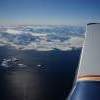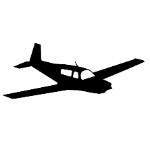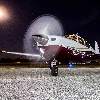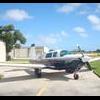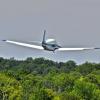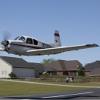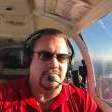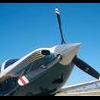Leaderboard
Popular Content
Showing content with the highest reputation on 07/18/2016 in all areas
-
Since top overhaul cylinder #4 was 30F-50F hotter than the other five jugs. In summer, it was hard to keep the #4 CHT below 400F in cruise. I went through many recommended diagnosis and fix steps: Cleaned fuel nozzles, cleaned and swapped plugs, checked JPI data for weak ignition, for induction leak and GAMI spread (.2 gal) - all no finding nor any impact. During another detailed inspection of the baffles (looked fine) I checked the oil cooler installation: It was sealed at the bottom with high temp RTV but it had a a big hidden gap at the upper part between oil cooler and firewall. Closed this gap with high temp RTV and ... #4 temperature dropped to normal level! Conclusion: Search for the obvious first! :-)7 points
-
So the answer is, the Cessna pilot should have: -Had the Cessna engine removed and then had a Mooney engine installed. and then -Had the Cessna airframe removed and had a Mooney airframe installed.4 points
-
Yeah, why listen to the folks who actually know what they're talking about when there are guys like Peter and Byron around to pontificate? Hey Bennett, Aaron, Philip, youse guys getting paid by PFS to shill for them? I don't need to shill for anybody. I freely admit I buy all sorts of "go fasts" for my Mooney, and I'm a bit of an avionics junky, but I don't think anyone else should follow my crazy pathway. I do so for my own pleasure. Fortunately I can just about afford to indulge myself. I am not taking away anything from from kids, nor my grown up grandkids. Flying, sailing, classic cars are all passions. I still work full time, owning a couple of businesses, and how I spend the money I earn is my own business.4 points
-
I figure I should close the loop on this for the benefit of anyone who might have a similar problem. The alternator was returned to the shop that overhauled it, they suspected a faulty diode but found none. However upon returning everything to service the cackling has stopped. Not one pop. Upon reinstallation my mechanic added a shielded ground wire to the field circuit. So either the act of removing and then reinstalling the alternator tightened up a previously loose connection or the shielded ground wire did the trick. FYI3 points
-
Just got off the phone with Roger Tucker, the chief mechanic at OSU. Either he or his mechanic will come down and fix the airplane. The fat lady hasn't yet sung, but it looks like Oshkosh is back on.3 points
-
If their in house guy cant weld like this find someone who can, Chassis Builders (drag racing) work with thin wall 4130 everyday, TIG (heli-arc) is the only way to have it done. What city/state are you in?3 points
-
And the answer is: "just another average flight in a Mooney"2 points
-
2 points
-
I needed to fly customers from the U.P. to Mankato, MN on Thursday and my Rocket was AOG for a leaking waste gate controller (internally leaking out the drain line). Customers wouldn't wait for my plane to be repaired (would drive over and buy from the dealer instead of my dealership on a transfer). Since the weather was generally good, and Steve offered up his "E" model (N1258X) which was a real need of some flying time, I decided to fly the customers over in the "E". Steve and I went up the day before to check the plane over (just out of annual and MANY calendar days since last flight). It was at that time I realized he has no autopilot. Not a deal stopper, but it's been over 15 years since I flown a plane without that "back-up" option. I found out really quick how much my hand flying skills had eroded from too much dependence on the autopilot. I DO fly without it, but generally turn it on even on those flights when dealing with "in cockpit issues". Within 20 minutes I was getting comfortable with it, but was amazed how quickly the plane would start rolling when I looked down for more than a couple seconds for radio and navigation adjustments, or other distractions. When I was just south of Minneapolis I was given a "descend and maintain 4,000'" from 6k and I started down. His E model has a bunch of speed mods, so descent management is more challenging than my Rocket (higher red line, 3 blade prop and speed brakes) without hitting the NE red line. After just 40-50 seconds I get another "repeat" of the original descent instruction (and I am down 500' already). I read back again and then a Supervisor comes on and asks me to expedite my descent. With throttle just above gear horn blaring, I get it down at 800' a minute with the airspeed just below red line. My next instruction after leveling at 4k is descend to 2800'. When I reply back, I add I had the plane just below red line to get his earlier request "to expedite descent". Later, with the airport in site and cancelling IFR, the Supervisor comes on and specifically thanks me for the help. .................Got to wonder, was he working a new controller? They sure didn't give me the descent instruction early enough to get what they wanted without extra work on my side (surely they didn't think I was a turbo prop with my "E model speed" flying into the wind). On the trip back I got some quality IMC time, which could have been avoided with either a 2k climb or descent, but I clearly needed the practice. I felt a lot better about my hand flying skills at the fourth hour than I did in the first 30 minutes. George is going to turned off a lot more frequently after that wake up call. My first 1300 hours of IFR was all done sans autopilot, with lots of hard IMC, but having that option since those days has sure made me lazy. Tom2 points
-
And when your other half kick you out of the house you have a place (hangar) to go and spend time with your lovely Mooney and sleep over together. Happy dreams. José2 points
-
2 points
-
A bunch of old guys that got tired of talking about Mooney mufflers and now they are into pilot's mufflers. José2 points
-
This is my viewpoint as well. That's 1,146 gallons of 100LL for my prices. Divided by 10 gallons an hour, that's over 100 hours of flight time at lets lay 135kts versus 0 hours at 140kts. Unless my exhaust needed replacing I doubt I would make the jump.2 points
-
Today's trip. I wish I could say it was from my plane. But seat 11A wasn't too bad. Sent from my iPad using Tapatalk2 points
-
1 point
-
I too have the MC Lifesaver with the battery backup. Yes, the battery is expensive, and I replace it at every other annual, but the presentation is clear and familiar. I have the "inclinometer" option for the "ball". All in all I am very pleased with unit. With all my other backups I see no reason to replace it with an EFIS variant (at least not now). Fly long enough and you will have some instrument or avionics failures - vacuum or electric. Redundancy can save your life, and in my opinion, a panel mounted unit that becomes part of your regular scan is easiest to transition to in an emergency.1 point
-
1 point
-
He had it back to 95knots.... 6gph. On 6gph LOP, I'm pushing 120 knots and 20nmpg. Why tinker with biofuel when you could just fly a Mooney instead?1 point
-
My plane came with the MCI Lifesaver with battery backup and it has been trouble-free for 9 years, except for expensive battery replacement. Having said that, I'd wait until OSH to make a decision since there might be new products or at least discounts on existing options. I too have a GDL 39 3D and a 496...their attitude indicators might really help in an emergency, but nothing beats having something on the panel within your normal scan IMO. Sent from my VS985 4G using Tapatalk1 point
-
Ok now I have something to work with. Based on the dick theme, you can name her: NIXON RICARDO HOLMES SHAFT ENIS Based on the 1CK: LOUIS (CK) LOUISA CALVIN (as in Klein) JEAN (as in the jeans) CHARLIE ANGEL1 point
-
There's always the Viking Route . . . . which is reputed to be workable for a C model, 52 gal, no ferry tank . . . . That isn't what got poor Yuri.1 point
-
Bruce, you might want to buy a ticket for the Mooney Caravan BBQ on Tuesday night in the North 40. I am sure that there will be a lot of MooneySpacers there as well. I attend every year even though I hadn't flown the Caravan. This year I am thrilled because I am! Also, make sure to stop by the Mooney International Pavilion, The Ambassadors/Mooney Girls there all week. And MAPA is close by too.1 point
-
I have read that the 4 banger and PF are NOT the combination that delivers gains of larger displacement engines where value is greater. I am not pontificating. I did my research and made my decision. I fly LOP. If I wanted to go 5 knots faster...and more. I can. I don't need a 4K exhaust to achieve speed gains.1 point
-
You said in another old thread you burn more fuel with the power flow. Yes or no? Cooler temps with higher fuel burn and a little more speed. No thank you.1 point
-
1 point
-
1 point
-
1 point
-
If/when they miss the 180 day target, just wait another 180 days and fly under the rules written In the bill. That'll be 15 July 2017. Then whenever the new regs come out, do whatever they say. Sure was nice if Congress to do that, after the FAA told 'em the last time that Congress' deadline would be missed because they were busy! Damned uppity, arrogant bureaucrats!!1 point
-
Make sure the holes in the tubing are caused by corrosion and not just holes drilled for PK screws that hold or might have held metal brackets for mounting ur plastic.1 point
-
Wow, that might be the most expensive tie down I've heard of....but I believe it. What airport are you at.1 point
-
I transitioned from a E to a J after a short ride with another pilot in the J and 10 hours in the E. The airplanes fly the same, don't worry about that. Spend an hour in the cockpit of the J mentally running through every move from start up to shut down. Find all the switches, levers etc., go over it several times in your mind. Mentally fly the mission. It's what the Blue Angels do before every flight. Then, go fly the plane. You will be fine. Jack1 point
-
Co-pilot jacks blew my ear drums out. Thought I'd already tried this, so I get the bone head award. Ill start with the jack. Thanks folks! Sent from my iPhone using Tapatalk1 point
-
I did mine 4 years ago independently with an independent instructor. Technically all the information needed is available from the FAA web site. I purchases several IFR book as well. I have posted before 1. start by looking at approach plates and learning the symbols on them and understanding what they are telling you 2. talk to instrument rated pilots 4. go up by in the plane on a good VFR day at an uncontrolled airport and fly the approaches while looking out the window to get the feel of where you are and what the instruments are telling you 5. find a safety pilot and get some hood time just flying point a to b and maneuvering the plane independent of approaches. 6. start using low altitude en-route charts for VFR flights and learn the symbols on them 7. Study the AIM on instrument procedures 8. find an instructor and get hood time form him as well as let him file IFR plan and get some real IMC time much different form hood time. 9. get one of the practice exam programs and take the written exam multiple times.1 point
-
I don't know Tom....although I'm not an "new" Mooney guy those exact thoughts were going through my head.....1 point
-
I'm hoping some new Mooney guy hasn't just joined Mooney Space and opened his computer to this 2nd page and it happens to be the first thread he reads on MS..lol..His thoughts, "What kind of guys are these Mooney guys?" Lube, anal, anus, tissue..... -Tom1 point
-
My guess on the delays is aligned with N601RX. They blocked out an annual inspection with you and you gave them a project. I think it is fair to sit down with ownership and map out a timeline. I also think you should have a conversation with the mechanic who maintained it for the past 5 years. You took it to a MSC to obviously see what your current mechanic was missing. Now you know. I would look to see if SB-208 was ever completed on the plane. Your previous mechanic should have verified that was completed. It is more than just inspecting the tubing, it also deals with insulation that promoted the corrosion. Sent from my iPad using Tapatalk1 point
-
At least on the 1975 version they are actually labeled with very small black letters. If you stare at them long enough with the light in the right direction there are words like Com1 and ADF. Then they go to a cannon plug and into a larger bundle of wires. then make it over to the breaker panel.1 point
-
Burden of proof isn't on me to establish something doesn't deliver claimed gains in speed. But how hard would it be to fly a NTPS 3-track profile at a couple different altitudes to establish a baseline and then quantify gains? Actually document it. I have done quite a few of these tests. You'll find a roller cam engine is fastest at 23 degrees timing, but a -D engine is faster at 25 degrees, for example. Lest just say I'm not sold on any benefits for the 4 grand it costs.1 point
-
I'm trying to figure out where I'm going to park 2652W. Looks like I'll be in Vintage Parking like Bob as I'll have a camper in Warbird Camping. I would rather not pay $27 a night and have an empty tent to be in North 40 Camping. Any thoughts or is my best option Vintage Parking? Thanks, David1 point
-
My POH (from 1975) doesn't give that info. That would be great, though. Since the OP has a J, he will have it, other IO360 models probably pretty close, FYI:1 point
-
Disagree. My main objections were 1) pilot experience (earned over a long time regardless of money) and 2) trying to commute reliably anywhere with real weather in a piston single, I don't care if it's a new acclaim or an older bird with TKS. So unless you're saying he could just buy a Citation or Pilatus, and hire a pro pilot full time companion, we are staying in the owner piloted Mooney realm, and the money angle is moot. Sent from my iPhone using Tapatalk1 point
-
As I understand it, the FIKI version requires two alternators for backup power, and it comes with two pumps. Two alternators were not available on the 231 so FIKI is only available on the 252, but having a 252 does not guarantee that it will have been the two pump fiki version. But also, as I understand it, it is the entire installation, engine combo that is in the paper work that makes it a fiki system. The paper work is everything when callung a system fiki and excercising the rights that go with that. So as I understand it, even if you had a fiki install of the tks in your 252, but then got the rocket stc after that, it will no longer be a fiki system even though you have two pumps. In part because now you do not have two alternators. But even if you get a second backup alternator (doesnt gami make some kind of second alternator that would fit the accessories port on the tsio520nb?) it still would not be fiki anymore since the engine and the alternators would not be as specified in the cav-aero fiki tks paperwork. So the fiki privledge is nul and void in a rocket if you had it in the first place. Regulations aside, the single pump tks has the same panel coverage and flow rates as the dual pump fiki system. Also, anthony I seem to have a night light. And by the way, in a rocket you have two big batteries which serves pretty well as backup power. I for one don't need fiki. I don't want to fly in ice. I just don't want to feel cornered just in case. I just want an out if I ever screw up which I duly try not to. I do not fly into ice knowing there is ice, and I wouldn't either in a fiki mooney - I would want at least a twin but probably a turbine if I wanted to fly often into ice. No fiki tks gives me a bit of peace of mind just in case just as would fiki.1 point
-
Something nice to be said for simply sitting in the hangar and having someone wander by for a chat. Sent from my iPad using Tapatalk1 point
-
I've had aircraft tied down in the open, under T-Shades, and mostly in hangars. I am bit of a hangar fanatic by most standards, but I find tremendous value in utilizing hangars. I set up a mini-office in my last two hangars, with a computer, printer, refrigerator, water cooler, coffee maker, desks, workbenches, drill press, tool storage,etc. plus cabinets to hold all the "stuff" I use for airplanes. I also added many shelves to hold storage boxes, catalogued, and cross catalogued for find the oddball things I know I have "somewhere". I could never manage this from a tie down. Here in the San Francisco Bay Area, hangar costs are ridiculously high, and the waiting lists are long. Even so, I cannot imagine leaving my Mooneys outside in the weather. Cessna 172s and Pipers, OK when I didn't have a hangar available, but even my Cessna 120 was hangared. If you are ever around KSQL come and visit . When I leave the hangar doors open, and work at my desk there are always pilots and friends stopping by to chat.1 point
-
You haven't read anything? So you are passing off your assumption as fact? The TCDS for the IO-390 (E00006NY) clearly states the HP rating is 210 at 2700 RPM for takeoff AND max continuous. It also states minimum fuel as 100LL (I was wrong). Cylinders are $3600 each vs. $2200 each. Slick mags are the only ones listed on th TCDS, your experience with their reliability is your own. I have both Slicks and CMI magd go 500 hours regularly without failure. If I was getting a factory engine, it would be the IO-390. I just overhaulled my IO-360-A1A for less than $15k, so obviously, that is a whole different ballgame.1 point
-
Done both in an out. When I lived in Boston a hangar was more than my rent. So she lived outside and through the last bits of Hurricaine Sandy. She did well, but then I moved to the Midwest. Harsh winters, industrial soot. I decided to move to an airport further away and got on the waiting list for hangars. Comparatively cheaper here. While waiting Murphy's law struck and my plane got damaged by hail. Since being in big storms move through and I no longer worry. My family enjoys hanging out at the hanagar. You make friends with your hangar neighbors. Plane is protected. You're preflighted and out in 15 minutes instead of 30. There's no misery in putting the cover on in 30kt howling winds. I'm not having to douse the plane in TKS fluid to get the ice / frost off. I don't have construction on the airport that blows sand and dust under my microfiber cover (none are perfect) that scratches and ruins the windshield. Hangar is the best thing I did for the airplane and my flying enjoyment. You can go for a month to month arrangement for a couple of months to see how you like it before committing.1 point
-
1 point
-
Uh, Oh!!! Those manual gear moniacs aren't going to like you refering to an electric gear Mooney as an up-grade! (However, as a 74 C owner, I completely agree with you!) Anyway, we're looking forward to you sharing some of your expertise/experience.1 point
-
No worries, if they investigate just have lunch with the attorney general. All your problems will magically disappear.1 point
-
Hmmm, sounds interesting. Depends on timing and weather. I'd really like not having to fly past the "temporary" restricted airspace around the Capital.1 point

